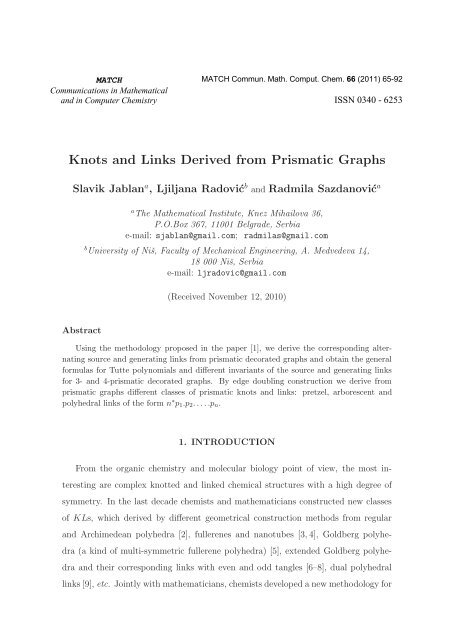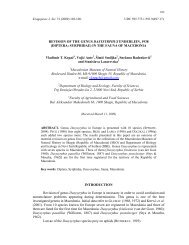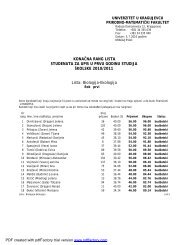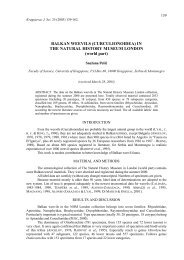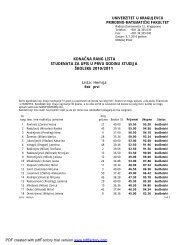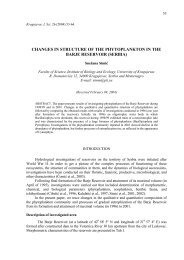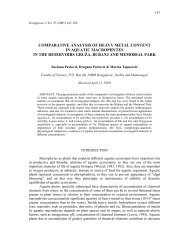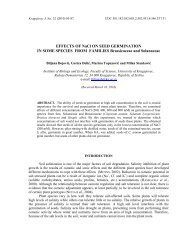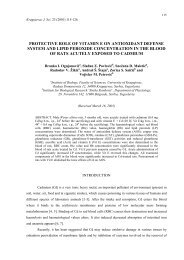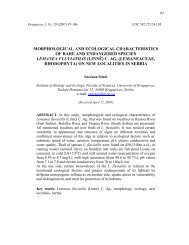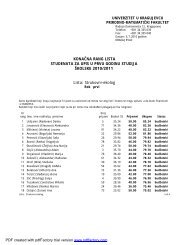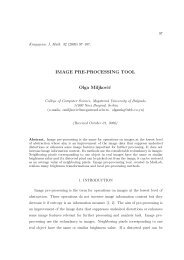S. Jablan, L. Radovic, R. Sazdanovic
S. Jablan, L. Radovic, R. Sazdanovic
S. Jablan, L. Radovic, R. Sazdanovic
You also want an ePaper? Increase the reach of your titles
YUMPU automatically turns print PDFs into web optimized ePapers that Google loves.
MATCH<br />
Communications in Mathematical<br />
and in Computer Chemistry<br />
Knots and Links Derived from Prismatic Graphs<br />
Slavik <strong>Jablan</strong> a , Ljiljana Radović b and Radmila Sazdanović a<br />
Abstract<br />
MATCH Commun. Math. Comput. Chem. 66 (2011) 65-92<br />
a The Mathematical Institute, Knez Mihailova 36,<br />
P.O.Box 367, 11001 Belgrade, Serbia<br />
e-mail: sjablan@gmail.com; radmilas@gmail.com<br />
b University of Niˇs, Faculty of Mechanical Engineering, A. Medvedeva 14,<br />
18 000 Niˇs, Serbia<br />
e-mail: ljradovic@gmail.com<br />
(Received November 12, 2010)<br />
Using the methodology proposed in the paper [1], we derive the corresponding alternating<br />
source and generating links from prismatic decorated graphs and obtain the general<br />
formulas for Tutte polynomials and different invariants of the source and generating links<br />
for 3- and 4-prismatic decorated graphs. By edge doubling construction we derive from<br />
prismatic graphs different classes of prismatic knots and links: pretzel, arborescent and<br />
polyhedral links of the form n ∗ p1.p2.....pn.<br />
1. INTRODUCTION<br />
ISSN 0340 - 6253<br />
From the organic chemistry and molecular biology point of view, the most in-<br />
teresting are complex knotted and linked chemical structures with a high degree of<br />
symmetry. In the last decade chemists and mathematicians constructed new classes<br />
of KLs, which derived by different geometrical construction methods from regular<br />
and Archimedean polyhedra [2], fullerenes and nanotubes [3, 4], Goldberg polyhe-<br />
dra (a kind of multi-symmetric fullerene polyhedra) [5], extended Goldberg polyhe-<br />
dra and their corresponding links with even and odd tangles [6–8], dual polyhedral<br />
links [9], etc. Jointly with mathematicians, chemists developed a new methodology for
-66-<br />
computing polynomial KL invariants: Jones polynomial [11, 12], Kauffman bracket<br />
polynomial [11–13] and HOMFLY polynomial [14, 15], and polynomial invariants of<br />
graphs: Tutte polynomials, Bolobás-Riordan polynomials, chromatic and dichromatic<br />
polynomials, chain and sheaf polynomials that can be applied to KLs withavery<br />
large number of crossings and their (signed) graphs. For the first time they analyzed<br />
chirality of KLs with a large number of crossings obtained as polyhedral links [16,17].<br />
In knot theory, a well-known construction methods for knots and links is the<br />
middle edge construction extended by F. Jaeger, which means each crossing in an<br />
edge mid-point is replaced by a twist collinear with the edge. Using the construction<br />
method, the HOMFLY polynomials of such links (called Jaeger links) can be<br />
computed from their Tutte polynomials by replacements of variables [18]. In the<br />
”generalized Jaeger construction” and ”generalized dual Jaeger construction” several<br />
crossings placed along an edge of a graph G are replaced by twists collinear or<br />
perpendicular to the edge [14].<br />
The next construction, called edge doubling, can be used for obtaining 4-regular<br />
graphs from 3-regular graphs: in every vertex of a 3-regular graph one edge is replaced<br />
by a double edge [4]. After that, obtained 4-regular graphs can be transformed into<br />
alternating or non-alternating KL diagrams.<br />
The concept of ”polyhedral links” is a novel and meaningful mathematical model,<br />
which is proposed by Qiu’s group for the first time in 2005. Since then, they have<br />
published a series of papers in this field.<br />
The first examples of highly-symmetrical nanometer-scale DNA regular polyhedra<br />
obtained by self-assembling are DNA cube (i.e., regular 4-prism) synthesized by N.C.<br />
Seeman and co-workers [19–21], and DNA octahedron (i.e., regular 4-bipyramid), designed<br />
by W.M. Shih and co-workers [22]. These results are followed by the synthesis<br />
of more complex, less symmetrical polyhedra: trigonal bipyramid created by one-step<br />
assembly [23], and a series of n-prisms including triangular prism, pentameric and<br />
hexameric prisms [24].<br />
Our paper builds on works of F. Jaeger, W.-Y. Qiu and his colleagues. In the<br />
paper [1] we proposed a general methodology for deriving knots and links (abbr.<br />
KLs) from polyhedral graphs and analyzing their properties. In this paper we extend
the results to decorated 3- and 4-prismatic graphs and obtain KLs from prism graph<br />
by the generalized Jaeger construction and prismatic KLs fromn-prisms by edge-<br />
doubling.<br />
-67-<br />
In Section 2 we consider basic polyhedra whose graphs are n-prisms and dual<br />
graphs are n-bipyramids (n � 3). Moreover, we extend the basic polyhedra 9 ∗ and<br />
12C to the families of generalized Jaeger 3- and 4-prism links. In Section 3 we derive<br />
general formulas for the Tutte polynomials of 3- and 4-prism decorated graphs. In<br />
Section 4 we give lists of source and generating alternating KLs derived from 3- and<br />
4-prism decorated graphs and compute their different invariants. From these source<br />
and generating alternating links we derive families of non-alternating KLs, compute<br />
various invariants and consider their properties, in particular chirality. In Subsection<br />
4.1 we provide ”portraits of families”, plots of zeros of the Jones polynomials of KL<br />
families corresponding to decorated prismatic graphs. In Section 5 we analyze KLs<br />
obtained by edge-doubling construction from prismatic graphs.<br />
Conway notation of KLs and definitions of all terms used in this paper are given<br />
in [1,4,25,26], and the definitions and explanations of different knot theory invariants<br />
are given in [1, 4, 27, 28]. Here we restate the definitions of a basic polyhedron, KL<br />
family, and source link:<br />
Definition 0.1. Basic polyhedron is a 4-regular, 4-edge-connected, at least 2-vertex<br />
connected plane graph without bigons.<br />
Definition 0.2. For a link or knot L given in an unreduced 1 Conway notation C(L)<br />
denote by S a set of numbers in the Conway symbol excluding numbers denoting<br />
basic polyhedron and zeros (determining the position of tangles in the vertices of<br />
polyhedron) and let ˜ S = {a1,a2,...,ak} be a non-empty subset of S. Family FS ˜(L) of knots or links derived from L consists of all knots or links L ′ whose Conway symbol<br />
is obtained by substituting all ai �=±1, by sgn(ai)|ai+kai |, |ai+kai | > 1, kai ∈ Z. [1,4]<br />
If all kai are even integers, the number of components is preserved within the<br />
corresponding subfamilies, i.e., adding full-twists preserves the number of components<br />
inside the subfamilies.<br />
1The Conway notation is called unreduced if in symbols of polyhedral links elementary tangles 1<br />
in single vertices are not omitted.
Definition 0.3. A link given by Conway symbol containing only tangles ±1 and±2<br />
is called a source link, and link given by Conway symbol containing only tangles ±1,<br />
±2 and±3 is called generating link.<br />
2. BASIC POLYHEDRA AND DECORATED GRAPHS DERIVED<br />
FROM n-PRISMS<br />
Basic polyhedron 9 ∗ is the first member of the family of basic polyhedra 9 ∗ ,<br />
12C=123 ∗ , 1599 ∗ , 184460 ∗ , ..., with 3n crossings, two n-gonal faces, 2n triangu-<br />
lar, and n 4-gonal faces, derived from n-prisms (n � 3) as middle graphs (Fig. 1.<br />
For n = 1 (mod 2) we obtain knots, for n = 2 (mod 4) 2-component links, and for<br />
n = 0 (mod 4) 4-component links, defined by braid words AbA(CbA) n−2 CbC [29].<br />
The signature of obtained KLsis<br />
n Signature<br />
3 2<br />
4 1<br />
n � 5 n − 1<br />
All 4-component links from this family have cutting number 2, and all obtained KLs<br />
are chiral. Since n-prisms and n-bipyramids are mutually dual, the same basic poly-<br />
hedra (i.e., their mirror image KLs) can be obtained as middle graphs corresponding<br />
to n-bipyramids.<br />
-68-<br />
Figure 1: Basic polyhedra 9 ∗ , 123 ∗ , 1599 ∗ , and 184460 ∗ .<br />
According to Conway’s construction, all polyhedral alternating KLs can be ob-<br />
tained from basic polyhedra by vertex substitutions, i.e., substituting vertices of basic<br />
polyhedra by algebraic tangles [4, 25]. Conway notation for polyhedral KLs is built
-69-<br />
on this idea. From the basic polyhedron 9 ∗ , by the vertex substitutions we obtain<br />
the family of alternating KLs9 ∗ e.a 0.i.f.b 0.g.d.c 0.h (Fig. 2a). Their corresponding<br />
graphs are decorated 3-prism graphs obtained by generalized Jaeger construction,<br />
illustrated in Fig. 2b.<br />
Figure 2: (a) KLs of the family 9 ∗ a5.a1 0.a9.a6.a2 0.a7.a4.a3 0.a8; (b) their corresponding<br />
3-prism decorated graph P3 = P3(a1,a2,...,a9).<br />
By vertex substitutions in the basic polyhedron 12C=123∗ we construct the family<br />
of alternating KLs given by Conway symbol 123∗a3.a11 0.a8.a4.a12 0.a5.a1.a9 0.a6.<br />
a2.a10 0.a7 (Fig. 3a). Their corresponding graphs are decorated 4-prism (cube) graphs<br />
obtained by generalized Jaeger construction, illustrated in Fig. 3b.<br />
Figure 3: (a) KLs of the family 123 ∗ a3.a11 0.a8.a4.a12 0.a5.a1. a9 0.a6.a2.a10 0.a7; (b)<br />
their corresponding 4-prism decorated graph P4 = P4(a1,a2,...,a12).
-70-<br />
3. GENERAL FORMULAS FOR TUTTE POLYNOMIALS OF 3- AND<br />
4-PRISMATIC DECORATED GRAPHS<br />
According to Thistlethwaite’s Theorem, the Jones polynomial of an alternating<br />
link, up to a factor, can be obtained from the Tutte polynomial by replacements:<br />
x →−x and y →− 1<br />
[30–32]. Moreover, from general formulas for Tutte polynomials<br />
x<br />
with negative values of parameters we obtain Tutte polynomials expressed as Laurent<br />
polynomials. By the same replacements we obtain, up to a factor, Jones polynomials<br />
of non-alternating links. Hence, from general formulas for Tutte polynomials we can<br />
obtain Jones polynomials of KLs without restriction on the number of crossings.<br />
It is well known that Tutte polynomials are not KL invariants, but they are<br />
invariants of minimal KL diagrams treated as signed graphs, and they are much<br />
stronger invariant than Jones polynomials obtained from them. For example, for the<br />
graph G corresponding to the minimal diagram of an amphicheiral knot or link L,<br />
TG(x, y) =TG(y, x). However, a chiral knot or link L given by its minimal diagram<br />
can have equal Jones polynomials of L and its mirror image, but TG(x, y) �=TG(y, x).<br />
In this section we derive general formulas for the Tutte polynomials of 3- and<br />
4-prismatic decorated graphs using the classical definition of Tutte polynomial and<br />
Theorem 0.1 ( [33], Theorem 3.1) stated below.<br />
An ear in a graph is a path v1 ∼ v2 ∼ ... ∼ vn ∼ vn+1 where d(v1) > 2,<br />
d(vn+1) > 2andd(v2) =d(v3) =... = d(vn) = 2. A cycle is viewed as a ”special”<br />
ear where v1 = vn+1 and the restriction on the degree of this vertex is lifted. If a<br />
graph contains an ear or a multi-edge, then all the edges involved can be removed by<br />
a single operation. We denote an ear with s edges by Es, and an edge of multiplicity<br />
s by es . Deletion of an ear G − Es is the deletion of all edges in Es. Contraction of a<br />
multi-edge G/Es consists of deleting all edges in Es and identifying the endvertices,<br />
while contracting an ear requires deleting all its edges and identifying v1 and vn+1.<br />
Theorem 0.1. [33] Suppose that G is a biconnected graph that properly contains an<br />
ear Es. Then<br />
T (G) = xs − 1<br />
x − 1 T (G − Es)+T (G/Es).
Since multiple edges are dual to ears, for multiple edges we immediately obtain<br />
the Tutte polynomial of a dual graph.<br />
-71-<br />
Figure 4: Graphs G1-G7.<br />
In order to derive general formulas for Tutte polynomials of 3- and 4-prism dec-<br />
orated graphs we need a few more basic graphs and general formulas for their Tutte<br />
polynomials [34]:<br />
• The Tutte polynomial of graphs G1 = G1(a) (Fig. 4) of a-cycle Ea is<br />
T (G1(a)) = xa − 1<br />
x − 1<br />
+ y − 1.<br />
• The Tutte polynomial of pretzel KL graphs (Fig. 4) G2 = G2(a, b, c) is<br />
T (G2(a, b, c)) = xa+b+c +(xa+1 + xb+1 + xc+1 )(y − 1) − (xa + xb + xc )y<br />
(x − 1) 2<br />
+<br />
(xy − x − y)(xy − x − y − 1)<br />
(x − 1) 2<br />
.<br />
• For graphs G3 = G3(a, b, c, d, e) (Fig. 4) we have the general formula for the<br />
Tutte polynomial:<br />
T (G3(a, b, c, d, e) = xe − 1<br />
x − 1 T (G(a, b, (c + d))) + T (G2(a, b, c)))T (G1(d)).<br />
• The general formula for graphs G4 = G4(a, b, c, d, e, f) (Fig. 4) is:<br />
T (G4(a, b, c, d, e, f)) = T (G3(a, b, d, e, f))+x d (Cc(x)+1)T (G1(a+b))T (G1(e+f)),
where<br />
-72-<br />
Cc(x) = xc − x<br />
x − 1 .<br />
• The Tutte polynomial of n+1-wheel graphs Wh(n+1) (i.e., n-pyramid graphs)<br />
(Fig. 4) is given by the general formula [34]:<br />
T (Wh(n +1))=[ 1<br />
2 [(1 + x + y)+[(1+x + y)2 − 4xy] 1/2 ]] n +<br />
[ 1<br />
2 [(1 + x + y) − [(1 + x + y)2 − 4xy] 1/2 ]] n + xy − x − y − 1.<br />
• The general formula for the Tutte polynomial of the decorated 3-pyramid graphs<br />
G5(a, b, c, d, e, f) (Fig. 4) is:<br />
T (G5) =T (G5(a, b, c, d, e, f) =Ca(x)T (G2(b+f,d,e))+Cb(x)T (G2(c+d, e, f+1))+<br />
Cc(x)T (G2(d +1,e+1,f)) + Cd(x)T (G2(e + f,2, 1))+<br />
Ce(x)T (G2(f +1, 2, 1)) + Cf(x)T2(G(2, 2, 1)) + T (Wh(4)).<br />
• The general formula for the Tutte polynomial of the decorated 4-pyramid graphs<br />
G6 = G6(a, b, c, d, e, f, g, h) (Fig. 4) is:<br />
G6(a, b, c, d, e, f, g, h) =<br />
Ca(x)T (G4(b + h, g, c, f, d + e)) + Cb(x)T (G4(c + g, f, d, e, h + 1))+<br />
Cc(x)T (G4(d + f,e,1,h,g+1))+Cd(x)T (G4(e +1,h,1,g,f + 1))+<br />
Ce(x)T (G5(2, 1, 1,g,f,h)) + Cf(x)T (G5(2, 1, 1,h,g,1))+<br />
Cg(x)T (G5(2, 1, 1, 1,h,1)) + Ch(x)T (G5(2, 1, 1, 1, 1, 1)) + T (Wh(5)).<br />
• The general formula for the Tutte polynomial of the decorated graphs G7 =<br />
G7(a, b, c, d, e, f, g, h, i) (Fig. 4) is:<br />
T (G7) =T (G7(a, b, c, d, e, f, g, h, i)) =<br />
(Ca(x)+1)T (G4(b + c, d, e, f, g, h + i)) + T (G6(d, f, g, e, b, h, i, c)).
Theorem 0.2. The Tutte polynomial of a decorated 3-prism graphs P3 = P3(a1,<br />
a2,a3,a4,a5,a6,a7,a8,a9) (Fig. 2b) is given by the general formula:<br />
T (P3) =P3(a1,a2,a3,a4,a5,a6,a7,a8,a9) =<br />
C1(x)T (G4(a8 + a9,a7,a3,a2,a4,a5 + a6)) + C2(x)T (G4(a7 + a9,a8,a3, 1,a5,a4 + a6))+<br />
where<br />
-73-<br />
C3(x)T (G4(a7 + a8,a9, 1, 1,a6,a4 + a5)) + C4(x)T (G5(a7,a9,a8, 1,a5 +1,a6 + 1))+<br />
C5(x)T (G5(a7,a8,a9,a6 +1, 1, 2)) + C6(x)T (G5(a7,a8,a9, 2, 2, 1))+<br />
C7(x)T (G5(1, 1, 1,a8 +1,a9 +1, 1)) + C8(x)T (G5(1, 1, 1,a9 +1, 2, 1))+<br />
C9(x)T (G5(1, 1, 1, 2, 2, 1)) + T (P3(1, 1, 1, 1, 1, 1, 1, 1, 1)),<br />
Ci(x) = xai − x<br />
x − 1 ,<br />
and P 1 3 = P3(1, 1, 1, 1, 1, 1, 1, 1, 1)) is the 3-prism graph with the Tutte polynomial<br />
T (P 1 3 )=4x +9x2 +8x 3 +4x 4 + x 5 +4y +13xy +9x 2 y +2x 3 y +8y 2 +7xy 2 +5y 3 + y 4 .<br />
The proof of this theorem follows from a series of recursive contractions/deletitions<br />
and applications of Theorem 0.1 in the process of the reduction of multiple edges which<br />
canbefollowedonFig.5.<br />
Theorem 0.3. Tutte polynomial of a decorated 4-prism graphs (Fig. 3b) P4 = P4(a1,<br />
a2,a3,a4,a5,a6,a7,a8,a9,a10,a11,a12) is given by the general formula:<br />
T (P4) =T (P4(a1,a2,a3,a4,a5,a6,a7,a8,a9,a10,a11,a12)) =<br />
C9(x)T (P3(a12,a10,a11,a3,a4,a1 + a2,a7,a8,a5 + a6))+<br />
C10(x)T (P3(1,a11,a12,a4,a1,a2 + a3,a8,a5,a6 + a7))+<br />
C11(x)T (P3(1, 1, 1,a1,a2,a3 + a4,a5,a6,a7 + a8))+<br />
C12(x)T (P3(1, 1, 1,a2,a3,a1 + a4,a6,a7,a5 + a8))+<br />
C1(x)T (G7(a5,a6,a2 +1, 1,a7,a3, 1,a8,a4 +1))+C2(x)T (G7(a6,a7,a3 +1, 1,a8,a4, 1,a5, 2))+<br />
C3(x)T (G7(a7,a8,a4 +1, 1,a5, 1, 1,a6, 2)) + C4(x)T (G7(a8,a5, 2, 1,a6, 1, 1,a7, 2))+<br />
C5(x)T (G7(1,a6 +1, 1, 1,a7, 1, 1,a8 +1, 1)) + C6(x)T (G7(1,a7 +1, 1, 1,a8, 1, 1, 2, 1))+<br />
C7(x)T (G7(1,a8 +1, 1, 1, 1, 1, 1, 2, 1)) + C8(x)T (G7(1, 2, 1, 1, 1, 1, 1, 2, 1)) + T (P 1 4 )<br />
where<br />
Ci(x) = xai − x<br />
x − 1 ,<br />
and P 1 4 = P4(1, 1, 1, 1, 1, 1, 1, 1, 1, 1, 1, 1)) is the 4-prism graph with the Tutte polynomial<br />
T (P 1 4 )=11x +32x 2 +40x 3 +29x 4 +15x 5 +5x 6 + x 7 +11y +46xy +52x 2 y +24x 3 y+<br />
6x 4 y +25y 2 +39xy 2 +12x 2 y 2 +20y 3 +8xy 3 +7y 4 + y 5 .
-74-<br />
Figure 5: Resolving graph P3 = P3(a1,a2,a3,a4,a5,a6,a7,a8,a9).<br />
Since n-prisms and n-pyramids are dual, the Tutte polynomials of decorated 3-<br />
and 4-bipyramid graphs can be obtained by switching variables x and y in the Tutte<br />
polynomials of decorated 3- and 4-prism graphs from Theorems 0.2 and 0.3.
4. ALTERNATING KL FAMILIES DERIVED FROM 3- AND<br />
4-PRISMATIC DECORATED GRAPHS<br />
To eliminate repeats of KLs by our construction we used minimal Dowker codes<br />
and Kauffman two-variable polynomials.<br />
Since the results for source and generating links derived from prismatic decorated<br />
graphs coincide, we are giving only the tables of generating links. Source links can<br />
be obtained from generating links replacing symbol 3 by 1.<br />
Among 512 generating links of the form 9∗a5.a1 0.a9.a6.a2 0.a7.a4.a3 0.a8 obtained<br />
from decorated 3-prism graphs, there are 74 different families, given in Table 4.1 by<br />
the lists of parameters a1,a2,...,a9.<br />
Table 4.1<br />
-75-<br />
1 2,3,3,2,2,3,3,2,2 2 2,2,3,2,3,2,2,3,3 3 2,3,3,3,2,2,3,2,2 4 2,2,3,2,2,3,2,3,3<br />
5 2,3,3,2,2,3,2,2,3 6 2,2,3,2,3,2,3,2,3 7 2,2,2,2,2,3,3,3,3 8 2,3,3,2,2,3,2,3,2<br />
9 2,2,2,2,3,3,3,2,3 10 2,3,3,3,2,2,3,2,3 11 2,3,3,2,2,3,3,2,3 12 2,2,3,2,2,3,3,3,3<br />
13 3,3,3,2,2,3,2,3,2 14 2,3,3,2,2,3,3,3,2 15 2,2,3,2,3,2,3,3,3 16 3,3,3,2,2,3,2,2,3<br />
17 2,2,3,2,3,3,3,3,2 18 2,2,3,2,3,3,3,2,3 19 2,3,3,3,2,3,3,3,2 20 2,2,3,2,3,3,3,3,3<br />
21 2,3,3,2,3,3,3,2,3 22 2,3,3,3,2,3,3,3,3 23 3,3,3,2,3,3,3,2,3 24 2,3,3,3,3,3,3,3,3<br />
25 3,3,3,3,3,3,3,3,3 26 2,3,3,2,2,2,3,2,2 27 2,3,3,2,2,2,2,2,3 28 2,2,3,2,2,2,2,3,3<br />
29 2,2,2,2,2,2,3,3,3 30 2,3,3,2,2,2,3,2,3 31 3,3,3,2,2,2,2,2,3 32 2,2,3,2,2,2,3,3,3<br />
33 2,2,3,2,3,2,2,3,2 34 2,2,3,2,3,2,3,2,2 35 2,2,2,2,2,3,2,3,3 36 2,2,3,2,3,2,3,3,2<br />
37 2,3,3,2,2,3,2,3,3 38 2,3,3,2,2,3,3,3,3 39 3,3,3,2,2,3,2,3,3 40 2,3,3,2,3,3,3,3,3<br />
41 3,3,3,2,3,3,3,3,3 42 2,2,3,2,2,3,2,3,2 43 2,2,2,2,2,3,3,3,2 44 2,2,3,2,2,3,3,3,2<br />
45 2,2,2,2,3,3,3,3,3 46 2,2,3,3,3,2,3,3,3 47 2,2,3,3,3,3,3,3,3 48 2,2,3,2,2,3,2,2,3<br />
49 2,2,3,2,3,3,2,3,3 50 2,3,3,2,3,3,3,2,2 51 3,3,3,2,2,3,3,3,2 52 2,3,3,3,2,2,3,3,3<br />
53 2,3,3,3,2,3,3,2,3 54 2,3,3,2,2,2,2,2,2 55 3,3,3,2,2,2,2,2,2 56 2,2,3,2,2,2,2,3,2<br />
57 2,2,2,2,2,2,2,3,3 58 2,2,3,2,2,2,3,3,2 59 2,3,3,2,2,2,2,3,3 60 3,3,3,2,2,2,2,3,3<br />
61 2,3,3,2,2,2,3,3,3 62 2,2,3,2,2,2,2,2,3 63 2,2,2,2,2,3,2,2,3 64 2,2,2,2,2,3,2,3,2<br />
65 2,2,2,2,3,3,2,3,3 66 2,2,3,3,3,2,3,3,2 67 2,3,3,2,3,3,2,3,3 68 3,3,3,2,2,3,3,3,3<br />
69 3,3,3,2,3,3,2,3,3 70 2,2,2,3,3,3,3,3,3 71 2,2,3,2,2,2,2,2,2 72 2,2,2,2,2,2,2,2,3<br />
73 3,3,3,2,2,2,3,3,3 74 2,2,2,2,2,2,2,2,2<br />
Number of components: First 25 families 1-25 are knots, 28 families 26-53<br />
are 2-component links, 17 families 54-70 are 3-component links, 3 families 71-73 are<br />
4-component links, and the family 74 consists of 5-component links.<br />
Cutting number: The number of components that needs to be cut in a link L<br />
in order to obtain split link is called the cutting number. It is an invariant of link<br />
families: all members of a KL family have the same cutting number. Certainly, for<br />
every 2-component link the cutting number is 1. However, cutting number is not<br />
necessarily equal to c − 1, where c is number of components.<br />
The families of source links 54, 60, 61, 66, 67, 71, 72, 74 and the families of<br />
generating links 54, 55 71, 74 have the cutting number c − 2, and all the other<br />
families of source and generating links have the cutting number c − 1.
-76-<br />
4096 generating links of the form 123 ∗ a3.a11 0.a8.a4.a12 0.a5.a1.a9 0.a6.a2 .a10 0.a7<br />
obtained from decorated 4-prism graphs belong to 144 different families, given in the<br />
Table 4.2.<br />
Table 4.2<br />
1 2,2,2,3,2,2,3,3,2,3,2,3 2 2,2,2,3,2,3,2,2,2,3,3,3 3 2,2,2,3,2,2,2,3,2,3,3,3<br />
4 2,2,2,3,2,2,3,2,2,3,3,3 5 2,2,2,3,2,2,2,3,3,3,2,3 6 2,2,2,3,2,2,3,3,3,3,2,2<br />
7 2,2,2,3,2,2,3,3,3,2,2,3 8 2,2,2,3,2,2,3,2,3,2,3,3 9 2,2,2,3,2,2,3,2,3,3,2,3<br />
10 2,2,2,3,2,3,3,2,3,2,2,3 11 2,2,2,3,2,3,3,2,3,2,3,2 12 2,2,2,3,2,2,3,3,2,3,3,3<br />
13 2,2,2,3,2,3,3,2,2,3,3,3 14 2,2,2,3,2,2,3,3,3,3,3,2 15 2,2,2,3,2,2,3,3,3,3,2,3<br />
16 2,2,2,3,2,2,3,3,3,2,3,3 17 2,2,2,3,3,2,3,3,2,3,2,3 18 2,2,2,3,2,3,3,2,3,3,2,3<br />
19 2,2,2,3,2,3,3,2,3,2,3,3 20 2,2,2,3,3,2,3,3,2,3,3,2 21 2,2,2,3,3,3,3,2,2,3,2,3<br />
22 2,2,2,3,2,3,3,2,3,3,3,2 23 2,2,2,3,2,3,3,3,3,3,2,3 24 2,2,2,3,2,2,3,3,3,3,3,3<br />
25 2,2,2,3,3,3,3,2,2,3,3,3 26 2,2,2,3,3,2,3,3,3,3,2,3 27 2,2,2,3,2,3,3,2,3,3,3,3<br />
28 2,2,2,3,2,3,3,3,3,2,3,3 29 2,2,2,3,3,3,3,3,2,3,2,3 30 2,2,3,3,3,3,2,2,3,2,3,3<br />
31 2,2,3,3,2,3,3,3,3,2,2,3 32 2,2,2,3,3,3,3,3,2,3,3,3 33 2,2,2,3,3,3,3,3,3,3,2,3<br />
34 2,2,3,3,2,3,3,3,3,3,2,3 35 2,2,3,3,2,3,3,3,3,2,3,3 36 2,2,2,3,3,3,3,3,3,3,3,3<br />
37 2,2,3,3,2,3,3,3,3,3,3,3 38 2,2,3,3,3,3,3,3,3,2,3,3 39 2,3,2,3,3,2,3,3,3,3,3,3<br />
40 2,3,3,3,3,2,3,3,3,3,2,3 41 2,2,2,2,2,3,2,3,2,2,3,3 42 2,2,2,2,2,2,3,3,2,3,2,3<br />
43 2,2,2,2,2,3,2,3,2,3,2,3 44 2,2,2,2,2,2,2,3,2,3,3,3 45 2,2,2,2,2,2,3,3,3,2,2,3<br />
46 2,2,2,2,2,3,3,3,2,2,2,3 47 2,2,2,2,2,2,2,3,3,3,2,3 48 2,2,2,2,3,3,3,3,2,2,2,2<br />
49 2,2,2,2,2,2,3,3,2,3,3,3 50 2,2,2,2,2,3,3,3,2,3,2,3 51 2,2,2,2,2,2,3,3,3,2,3,3<br />
52 2,2,2,2,2,3,3,3,2,2,3,3 53 2,2,2,2,3,3,3,3,2,2,2,3 54 2,2,2,2,2,2,3,3,3,3,2,3<br />
55 2,2,2,2,3,3,3,3,2,3,2,3 56 2,2,2,2,2,3,3,3,3,2,3,3 57 2,2,2,2,2,2,3,3,3,3,3,3<br />
58 2,2,2,2,3,3,3,3,2,3,3,3 59 2,2,2,2,3,3,3,3,3,3,3,3 60 2,2,2,3,2,3,2,3,3,3,2,3<br />
61 2,2,2,3,2,3,2,3,2,3,3,3 62 2,2,2,3,3,2,3,2,3,3,2,3 63 2,2,2,3,2,3,3,3,3,3,3,2<br />
64 2,2,2,3,2,3,3,3,2,3,3,3 65 2,2,2,3,3,3,3,2,3,3,2,3 66 2,2,3,3,2,3,2,3,3,2,3,3<br />
67 2,2,3,3,2,3,2,3,3,3,2,3 68 2,2,2,3,2,3,3,3,3,3,3,3 69 2,2,3,3,2,3,2,3,3,3,3,3<br />
70 2,2,3,3,3,3,2,3,3,2,3,3 71 2,2,2,3,3,3,3,2,3,3,3,3 72 2,2,2,3,2,2,3,2,3,2,2,3<br />
73 2,2,2,3,2,2,2,3,2,3,2,3 74 2,2,2,3,2,2,3,2,3,2,3,2 75 2,2,2,3,2,2,3,3,3,2,3,2<br />
76 2,2,3,3,3,3,2,2,2,3,2,3 77 2,2,3,3,3,3,2,2,2,3,3,3 78 2,2,3,3,3,3,2,3,2,3,3,3<br />
79 2,2,3,3,3,3,2,2,3,3,3,3 80 2,2,3,3,3,3,3,3,3,3,2,3 81 2,2,3,3,3,3,3,3,2,3,3,3<br />
82 2,2,3,3,3,3,3,3,3,3,3,3 83 2,3,3,3,3,2,3,3,3,3,3,3 84 2,2,2,3,2,2,3,2,3,3,3,3<br />
85 2,3,2,3,3,2,3,2,3,3,3,3 86 2,2,2,3,3,3,3,2,2,2,3,3 87 2,2,2,3,3,2,3,3,3,3,2,2<br />
88 2,2,3,3,2,2,3,3,3,3,2,3 89 2,2,2,3,2,3,3,3,3,2,2,3 90 2,2,2,3,3,2,3,3,2,3,3,3<br />
91 2,2,2,3,3,3,3,3,2,2,3,3 92 2,2,2,3,3,3,3,3,3,3,2,2 93 2,2,2,3,3,2,3,3,3,3,3,3<br />
94 2,2,3,3,2,2,3,3,3,3,3,3 95 2,2,2,3,2,3,2,2,2,3,2,3 96 2,2,2,3,2,2,3,2,2,3,2,3<br />
97 2,2,2,3,2,2,2,3,3,3,2,2 98 2,2,2,3,2,3,3,2,2,3,2,3 99 2,2,2,3,2,3,2,2,3,3,3,3<br />
100 2,2,2,3,2,2,2,3,3,3,3,3 101 2,2,3,3,3,3,2,2,3,2,3,2 102 2,2,3,3,2,3,3,2,3,2,2,3<br />
103 2,2,3,3,2,3,3,2,3,2,3,3 104 2,2,3,3,2,3,3,2,3,3,3,3 105 2,2,3,3,3,3,2,3,3,3,3,2<br />
106 2,3,2,3,3,3,3,3,3,3,3,3 107 2,2,2,2,2,2,2,3,2,2,3,3 108 2,2,2,2,2,2,3,3,2,2,2,3<br />
109 2,2,2,2,2,2,2,3,2,3,3,2 110 2,2,2,2,2,2,2,2,2,3,3,3 111 2,2,2,2,2,2,3,3,2,2,3,3<br />
112 2,2,2,2,2,3,2,3,2,3,3,3 113 2,2,2,2,2,3,3,3,2,3,3,3 114 2,2,2,2,2,3,3,3,3,3,3,3<br />
115 2,2,2,2,2,2,2,3,2,3,2,3 116 2,2,2,2,2,2,3,3,3,2,2,2 117 2,2,2,2,2,2,2,3,3,3,2,2<br />
118 2,2,2,2,2,2,3,3,3,2,3,2 119 2,2,2,2,2,2,2,3,3,3,3,3 120 2,2,2,2,2,3,3,3,3,2,2,3<br />
121 2,2,2,2,3,3,3,3,2,2,3,3 122 2,2,2,3,2,3,2,3,3,3,3,3 123 2,3,2,3,2,3,3,3,3,3,3,3<br />
124 2,2,2,3,3,2,3,2,3,3,2,2 125 2,2,2,3,3,3,3,2,3,3,2,2 126 2,2,3,3,3,3,2,3,3,3,2,3<br />
127 2,2,3,3,3,3,2,3,3,3,3,3 128 2,2,2,3,3,2,3,2,3,3,3,3 129 2,2,2,3,2,2,3,2,3,2,2,2<br />
130 2,3,3,3,3,3,3,3,3,3,3,3 131 2,2,2,2,2,2,2,3,2,2,2,3 132 2,2,2,2,2,2,2,2,2,2,3,3<br />
133 2,2,2,2,2,2,3,3,2,2,3,2 134 2,2,2,2,2,3,2,3,2,3,3,2 135 2,2,2,2,2,3,3,3,2,3,3,2<br />
136 2,2,2,2,2,2,2,3,2,3,2,2 137 2,2,2,2,2,2,2,2,2,3,2,3 138 2,2,2,2,2,2,2,2,3,3,3,3<br />
139 2,2,2,2,2,3,2,3,3,3,3,3 140 2,3,2,3,2,3,2,3,3,3,3,3 141 2,3,3,3,3,3,2,3,3,3,3,3<br />
142 3,3,3,3,3,3,3,3,3,3,3,3 143 2,2,2,2,2,2,2,2,2,2,2,3 144 2,2,2,2,2,2,2,2,2,2,2,2
-77-<br />
Number of components: First 40 families 1-40 are knots, 66 families 41-106<br />
are 2-component links, 24 families 107-130 are 3-component links, 12 families 131-<br />
142 are 4-component links, one 5-component family 143, and the family 144 consists<br />
of 6-component links.<br />
Cutting number: Among source links derived from 3-prismatic decorated graphs<br />
8 have cutting number c − 2: 3-component source links 54, 55, 66, 68, and70, 4component<br />
source links 71 and 73, and 5-component source link 74. The only source<br />
link with Borromean property, which splits after cutting any its component, is the<br />
3-component link 70: 9∗ .20 : .20 : .2 0. Four generating links: 3-component links<br />
54 and 55, 4-component link 71, and 5-component link 74 have the cutting number<br />
c − 2, but none of them has Borromean property.<br />
Among source links derived from 4-prismatic decorated graphs 13 of them have<br />
cutting number c − 2: 3-component source links 110, 121, 126, 127 and 128, 4component<br />
links 132, 135, 137, 138, 139, and141, 5-component link 143, and<br />
6-component link 144. None of them has Borromean property.<br />
Chirality: All source and generating links from the above lists are chiral.<br />
Other invariants: Several other invariants of the source links 1-74 are given in<br />
Table 4.3, where BJ-unlinking number is denoted by uBJ, ∞-unlinking number by<br />
u∞, adequacy number by a, splitting number by sp, signature by s, hyperbolic volume<br />
by hv, periodsbyp, order of the symmetry group of the corresponding polyhedron<br />
by sym, and linking number by l.<br />
Table 4.3<br />
u BJ u∞ a sp s hv p sym l uBJ u∞ a sp s hv p sym l<br />
1 3 4 28 2 22.9236 0 1 38 2 3 20 2 3 19.7367 0 1 1<br />
2 2 4 27 4 22.577 0 1 39 3 2 22 2 5 20.1045 0 1 1<br />
3 3 4 27 0 22.8496 2 4 40 3 3 18 2 1 18.1333 2 2 1<br />
4 3 5 28 4 22.7508 0 1 41 2 3 16 2 3 16.7127 2 2 1<br />
5 3 4 30 4 23.1429 2 2 42 3 1 32 3 5 24.2397 0 1 1<br />
6 3 4 26 2 22.5309 0 1 43 3 1 28 3 5 23.7263 2 2 1<br />
7 3 4 23 4 22.1811 2 2 44 4 1 26 4 1 22.5856 2 2 1<br />
8 3 4 30 4 23.0947 2 2 45 3 3 20 3 3 20.6149 2 2 0<br />
9 3 5 24 4 22.169 2 2 46 2 3 18 2 3 19.2668 2 2 2<br />
10 3 5 23 4 21.225 0 1 47 2 3 16 2 1 17.761 2 4 0<br />
11 3 4 24 4 21.3619 0 1 48 4 2 34 4 5 24.4626 2 4 0<br />
12 2 4 22 2 21.0874 2 2 49 3 2 24 3 3 21.078 2 2 0<br />
13 3 4 26 6 21.7517 2 2 50 3 3 24 3 1 21.2899 2 2 0<br />
14 3 5 24 2 21.3284 0 1 51 3 1 22 3 5 20.045 2 2 2<br />
15 3 4 21 4 20.8992 0 1 52 3 1 19 3 3 19.5908 2 2 0<br />
16 3 4 26 6 21.8355 2 4 53 3 1 20 2 3 19.6449 2 2 0<br />
17 2 4 22 0 20.9137 0 1 54 5 2 39 5 4 26.1739 2 4 2<br />
18 4 5 23 4 21.0456 2 2 55 7 2 35 6 8 25.0323 2,3 12 6<br />
19 4 5 20 4 19.6209 2 2 56 5 2 36 5 6 25.6704 0 1 2<br />
20 2 4 19 2 19.4094 0 1 57 5 2 33 5 6 25.2408 2 2 4<br />
21 2 4 21 0 19.7302 0 1 58 7 2 29 6 2 24.0056 2 2 6<br />
22 2 5 17 2 18.0173 0 1 59 6 3 29 5 2 22.9882 2 2 5<br />
23 2 3 19 4 18.3943 2 2 60 5 2 25 4 6 21.6749 2 2 3<br />
24 2 4 15 0 16.4108 2 4 61 4 2 22 4 4 21.2337 2 2 1<br />
25 2 2 14 2 15.0183 2,3 12 62 5 1 38 5 6 25.8537 2 2 1<br />
26 3 3 32 3 3 24.4685 2 2 1 63 5 2 35 5 6 25.3681 2 4 3<br />
27 3 3 34 3 5 24.6319 0 1 1 64 5 1 34 5 6 25.3158 2 2 1<br />
28 3 4 31 3 5 24.1447 0 1 1 65 6 2 25 6 4 22.1942 2 4 6<br />
29 3 3 26 3 5 23.6633 3 6 3 66 4 1 21 4 0 20.7946 2 4 2<br />
30 3 3 27 3 3 22.8603 0 1 1 67 4 2 23 4 0 19.8873 2 4 1<br />
31 5 3 30 3 7 23.3927 2 2 3 68 3 1 18 3 4 18.3786 2 2 2<br />
32 3 3 24 3 5 22.4771 2 2 1 69 5 1 19 5 4 18.4371 2 4 5<br />
33 3 3 31 3 5 24.1121 2 2 2 70 4 0 17 4 2 19.0564 2,3,6 12 0<br />
34 3 3 30 3 3 24.0462 2 2 0 71 7 1 43 7 5 27.2861 0 4 2<br />
35 3 3 29 3 5 23.7625 0 1 0 72 7 1 40 7 7 26.8349 2 2 4<br />
36 3 3 25 3 1 22.4306 0 1 2 73 5 0 20 5 5 19.9548 2,3 6 3<br />
37 2 2 26 2 1 21.495 0 1 1 74 9 0 47 9 2 28.3492 2,3 12 9
-78-<br />
4.1. ZEROES OF JONES POLYNOMIAL AND PORTRAITS OF KL-<br />
FAMILIES<br />
Plots of all zeroes of the Jones polynomial for KL family, referred to as the<br />
characteristic ”portrait of family”. We interpret these plots in the light of results<br />
in [35–40].<br />
Portrait of the alternating 3-prism KL family 9 ∗ a5.a1 0.a9.a6.a2 0.a7.a4.a3 0.a8 for<br />
2 � ai � 4, 1 � i � 9, is given in Fig. 6.<br />
Figure 6: Portrait of the family 9 ∗ a5.a1 0.a9.a6.a2 0.a7.a4.a3 0.a8 for 2 � ai � 4,<br />
1 � i � 9.<br />
Portrait of the alternating 4-prism KL family 123 ∗ a3.a11 0.a8.a4.a12 0.a5.a1.a9 0.a6<br />
.a2.a10 0.a7, 2� ai � 4, 1 � i � 12, is given in Fig. 7.<br />
Figure 7: Portrait of the family 123 ∗ a3.a11 0.a8.a4.a12 0.a5.a1.a9 0.a6.a2.a10 0.a7 for 2 �<br />
ai � 4, 1 � i � 12.<br />
Fig. 8 shows the portrait of the alternating KL family 6 ∗ a1.a2.a3.a4.a5.a6 for 2 �<br />
ai � 6, 1 � i � 6. The subfamily of amphicheiral KLsoftheform6 ∗ a1.a1.a2.a3.a3.a2<br />
for 2 � ai � 7, 1 � i � 3, and the subfamily of amphicheiral KLs oftheform<br />
6 ∗ a1.a2.a3.a1.a2.a3 for 2 � ai � 7, 1 � i � 3, from the preceding portrait are<br />
distinguished in Fig. 9.<br />
Figures 6-8 suggest that almost all of the roots of the Jones polynomials approach<br />
the unit circle under twisting 1 , they are dense in the unit circle [39], and critical<br />
points are the third [35, 36] and sixth roots of unity.<br />
1 Adding a twist changes the corresponding parameter in a Conway symbol by ±1.
Figure 8: Portrait of the KL family 6 ∗ a1.a2.a3.a4.a5.a6 for 2 � ai � 6, 1 � i � 6.<br />
Figure 9: (a) Portrait of the subfamily of amphicheiral KLs of the form<br />
6 ∗ a1.a2.a3.a3.a2.a1 for 2 � ai � 7, 1 � i � 3; (b) portrait of the subfamily of<br />
amphicheiral KLsoftheform6 ∗ a1.a2.a3.a1.a2.a3 for 2 � ai � 7, 1 � i � 3.<br />
5. KL FAMILIES DERIVED FROM n-PRISMS BY EDGE DOUBLING<br />
Every n-prism for n � 3 is a 3-regular graph – every vertex is 3-valent. Knowing<br />
that every 4-regular graph represents a shadow of a KL, we can transform n-prisms<br />
into 4-regular graphs by edge doubling: in every vertex substitute an edge by double<br />
edge to obtain 4-regular graph [4].<br />
In order to derive alternating source KLsfromn-prisms by edge-doubling, we need<br />
to enumerate all different edge-bicolored graphs. The edge-bicolored graphs obtained<br />
from n-prisms for 3 � n � 6, where double edges are denoted by bold lines are shown<br />
in Fig. 10. For n = 3, we get alternating source links 2 2 2 and 2, 2, 2, for n =4the<br />
alternating source links 2, 2, 2, 2and(2, 2) (2, 2) 2 ,forn = 5 the alternating source<br />
links 2, 2, 2, 2, 2, (2, 2), 2, 2, 2and(2, 2), (2, 2), 2, for n = 6 the alternating source links<br />
2, 2, 2, 2, 2, 2, (2, 2), 2, 2, 2, 2, (2, 2), (2, 2), 2, 2, (2, 2), 2, (2, 2), 2, (2, 2), (2, 2), (2, 2) and<br />
6 ∗ 2.2.2.2.2.2, etc. (Fig. 11).<br />
The numbers of different edge-bicolorings of n-prisms for 3 � n � 25 are given in<br />
the following tables:<br />
n 3 4 5 6 7 8 9 10 11 12 13 14<br />
2 2 3 6 5 9 10 16 19 32 41 65<br />
n 15 16 17 18 19 20 21 22 23 24 25<br />
94 144 211 330 493 767 1170 1812 2787 4342 6713<br />
2 Notice that 2, 2, (2, 2) = (2, 2) (2, 2).<br />
-79-
Figure 10: Edge-bicolored n-prism graphs for n =3, 4, 5, 6.<br />
Notice that this sequence is not included in the On-line Encyclopedia of Integer Sequences<br />
[41].<br />
By substituting single bigons by chains of bigons (k-twists) in source links we<br />
obtain different classes of prismatic links. Among all Prismatic source links obtained<br />
by Edge-Doubling (PED-links), there is only one rational link: 2 2 2 obtained from<br />
a 3-prism. All the other source PED-links can be divided into three classes: pretzel<br />
links p1,p2,...,pn (n � 3), arborescent links [4, 26] derived from the pretzel source<br />
links by substituting one or more tangles 2 by tangles (2, 2), and polyhedral links<br />
of the form n p<br />
1.p2.....pn (for even n � 6). The only PED-link with two different<br />
minimal diagrams is the rational link 2 2 2, and all the other links have a single<br />
minimal diagram each.<br />
In particular, for every n � 3 we obtain pretzel source link 2, 2,...,2, where<br />
number 2 occurs n times. By substituting bigons by pk-twists (1 � k � n, pk � 2),<br />
we obtain all alternating pretzel links p1,p2,...,pn.<br />
The number of different alternating generating pretzel links is equal to the number<br />
necklaces of the length n, colored with at most two colors and invariant with regard to<br />
the dihedral symmetry group Dn. According to the Pólya enumeration theorem [42]<br />
this number is given by the general formula:<br />
1<br />
2n<br />
�<br />
d|n<br />
-80-<br />
ϕ(n)2 n<br />
d +2 n−1<br />
2 for n odd
Figure 11: Alternating source KLs obtained from edge-bicolored prism graphs for<br />
n =3, 4, 5, 6.<br />
1<br />
2n<br />
�<br />
d|n<br />
-81-<br />
ϕ(n)2 n<br />
d +2 n<br />
2 −1 +2 n<br />
2 −2<br />
for n even<br />
where ϕ(n) is Euler’s totient function, counting the number of positive integers i less<br />
than n such that GCD(n, i) =1. Ifn = p k1<br />
1 p k2<br />
2 ...p ki<br />
i ,wherep1, p2, ..., pi are different<br />
prime numbers, and k1, k2, ..., ki are positive integers, then ϕ(n) =n �i 1<br />
k=1 (1 − pi ).<br />
Hence, the number of pretzel source links for 3 � n � 20 is given by the sequence<br />
A000029 from the On-Line Encyclopedia of Integer Sequences [41]:<br />
n 3 4 5 6 7 8 9 10 11 12 13 14 15 16 17 18 19 20<br />
4 6 8 13 18 30 46 78 126 224 380 687 1224 2250 4112 7685 14310 27012<br />
Theorem 0.4. If the number of odd parameters pk in a pretzel link p1,p2,...,pn is<br />
q (0 � o � n − 1), the number of components c of the pretzel link is c = n − q. Ifall<br />
parameters pk are odd, the number of components is 2 for even n, and1foroddn.<br />
Next invariant we consider for pretzel links is uBJ unknotting number. For pretzel<br />
links of the form p1,p2,p3 the following theorem holds [4]:<br />
Theorem 0.5. • The family 2k +1, 2l +1, 2m +1 (k � l � m � 2) has uBJ =<br />
l + m.<br />
• the family 2k, 2l, 2m has uBJ = u = k + l + m 3<br />
• for pretzel knots 2k +1, 2l, 2m +1 with (k � m � 1) we have4 2k +1, 2l, 2m +1 uBJ<br />
l =1 m + k<br />
k � l>1 m + k<br />
l>k� 1 m + k +1<br />
• 2k, 2l +1, 2m (k � m) has uBJ = u = k + l 5 .<br />
3 Notice that the linking number guarantees that uBJ = u.<br />
4 Notice that in first two cases, l =1andk � l>1, the signature guarantees that uBJ = u.<br />
5 Notice that the signature guarantees that uBJ = u.
-82-<br />
For pretzel links of the form L = p1,p2,...,pn with n � 4andwithallpk�2 we conjecture that uBJ-unknotting numbers can be computed in the following way:<br />
if the generating link of L is L ′ = p ′ 1 ,p′ 2 ,...,p′ n , and distance d between L and L′ is<br />
d = �n pi−p<br />
i=1<br />
′ i ,thenuBJ(L) =uBJ(L 2 ′ )+d, whereuBJ(L ′ )=3[ n<br />
2 ]ifallp′ i are odd<br />
(i.e., if all p ′ i are equal to 3), and otherwise uBJ(L ′ )=n.<br />
For every non-oriented knot K, we have two different orientations and two oriented<br />
knots denoted by K ′ and K ′′ .<br />
Definition 0.4. AknotK is called invertible (or reversible) if oriented knots K ′ and<br />
K ′′ are equivalent. Otherwise, it is called non-invertible.<br />
The existence of non-invertible knots was shown by H. F. Trotter (1963), who<br />
discovered non-invertible knot 7, 5, 3 and the whole family of non-invertible pretzel<br />
knots (2p +1), (2q +1), (2r +1)(p �=q, p �=r, q �=r) (Fig. 12) 6 Unlike in 1963, now<br />
we know that almost all knots are non-invertible [28].<br />
L. Kauffman and S. Lambropoulou proved that all oriented rational KLs are<br />
invertible ( [43], Theorem 1.21). Hence, the first algebraic non-invertible knots appear<br />
among pretzel knots.<br />
Figure 12: Non-invertible pretzel knot 7, 5, 3.<br />
No general technique is known for determining if a knot is invertible. The program<br />
SnapPea [45] by J. Weeks (whose 2.0 version is also part of Knotscape)andSnapPy [45]<br />
by M. Culler and N. Dunfield compute knot symmetry group and detect non-invertible<br />
knots. However, in the case of pretzel knots we can propose a simple geometrical<br />
criterion [4].<br />
Every pretzel knot p1,p2,...,pn (n � 3) can be drawn as a regular n-gon with<br />
vertices denoting pk-tangles, called t-diagram. Vertices in a t-diagram are treated as<br />
symmetric, and the mirror line contains at least one vertex.<br />
Conjecture 0.1. A pretzel knot is non-invertible iff all pk (1 � k � n) areodd7and its t-diagram is not mirror-symmetric.<br />
Knot 7, 5, 3 is the smallest pretzel knot without mirror-symmetrical t-diagram.<br />
Hence, it is non-invertible. The Fig. 13 illustrates the Conjecture 0.2, where pretzel<br />
knots 3, 3, 3, 5, 7and3, 3, 5, 3, 7 are non-invertible, since their t-diagrams are not<br />
mirror-symmetric, and the knot 3, 5, 5, 3, 7 is invertible.<br />
6 The proof of their non-invertibility can also be found in the book [27], (Theorem 11.11).<br />
7 According to Theorem 0.4, n must be an odd number.
-83-<br />
Figure 13: t-diagrams of non-invertible pretzel knots 3, 3, 3, 5, 7and3, 3, 5, 3, 7, and<br />
invertible pretzel knot 3, 5, 5, 3, 7.<br />
From arborescent PED-source links corresponding to n-prisms, we derived 12<br />
generating links for n =4,32forn =5,88forn = 6, 204 for n = 7, 522 for n =8,<br />
and 1714 for n =9. Forn = 6 we derived 13 polyhedral links, for n =8theirnumber<br />
is 30, and for n = 10 we derived 78 polyhedral generating PED-links. Generating<br />
links we distinguished by computing their minimal Dowker codes. Notice that among<br />
the generating PED-links there are many mutant KLs that cannot be distinguished<br />
by polynomial KL invariants.<br />
The number of components of pretzel KLs is given by Theorem 04. In order to<br />
compute the number of components of an arborescent PED-link we need to introduce<br />
a type of tangle [4]. All tangles can be divided into three basic types: [0], [1], and [∞]<br />
(Fig. 14a). In arborescent KLs we distinguish:<br />
• standard tangles of the types [0] and [1] – single ”vertical” even and odd twists;<br />
• tangles of the type [1] that consist from two parallel horizontal odd tangles.<br />
Hence, they act as standard tangles of the type [1];<br />
• two kinds of tangles of type [0]:<br />
(i) tangles which consist from an odd an even horizontal twist. Hence, they act<br />
as standard tangles of the type [0], and<br />
(ii) tangles which consist of two even twists. They act as standard tangles of<br />
the type [0], but add one more component. Hence, they are denoted by [0] 1 .<br />
In order to compute the number of components of an arborescent PED-link, it<br />
is sufficient to substitute tangles by their corresponding graphical type-symbols and<br />
count the number of components of the obtained link. For example, type-symbol<br />
[∞][∞][∞][0] 1 [0] 1 [0] 1 corresponds to the generating link 2, 2, 2, (2, 2), (2, 2), (2, 2),<br />
so it has 6 components (Fig. 14b). The type-symbol [1] [1] [∞] [0] [0] [0] corresponds<br />
to the generating link 3, 3, 2, (3, 2), (3, 2), (3, 2), so it is a knot (Fig. 14c). Naturally,<br />
all KLs with a common generating link have the same number of components.<br />
Besides pretzel KLs, probably the most interesting from the chemistry point of<br />
view are links of the form (p1,p2)(p3,p4) obtained from a cube, and polyhedral links<br />
of the form n ∗ p1.p2.....pn obtained from n-prisms for even n � 6. They are given by<br />
braid words A p1 b p2 A p3 b p4 ,andA p1 b p2 ...A pn−1 b pn , respectively.<br />
Among all source PED-links only amphicheiral links are (2, 2) (2, 2) derived by<br />
edge-bicoloring of 4-prism (i.e., a cube), and polyhedral links of the form n ∗ 2.2.....2
-84-<br />
Figure 14: (a) Types of tangles; (b) the number of components of the generating<br />
link 2, 2, 2, (2, 2), (2, 2), (2, 2) is 6; (c) the number of components of<br />
3, 3, 2, (3, 2), (3, 2), (3, 2) is 1.<br />
obtained from n-prisms for even n (n � 6). These source links generate infinite<br />
families of amphicheiral PED-links. From the source link (2, 2) (2, 2) we obtain the<br />
infinite family of amphicheiral links (p, q)(p, q), from 6 ∗ 2.2.2.2.2.2 two families of<br />
amphicheiral KLs: 6 ∗ p.q.r.r.q.p and 6 ∗ p.q.r.p.q.r (Fig. 15a), from 8 ∗ 2.2.2.2.2.2.2.2the<br />
family 8 ∗ p.q.r.s.s.r.q.p, from10 ∗ 2.2.2.2.2.2.2.2.2.2 two families: 10 ∗ p.q.r.s.t.t.s.r.q.p,<br />
and 10 ∗ p.q.r.s.t.p.q.r.s.t, etc.<br />
According to [47], a KL with a single minimal diagram is amphicheiral iff its graph<br />
G is self-dual. Since all polyhedral KLs derived from n-prisms by edge-doubling have<br />
a single minimal diagram, we have the following theorem:<br />
Theorem 0.6. From n-prisms by edge-doubling we derive exactly two kinds of amphicheiral<br />
polyhedral KLs of the following form:<br />
• (2k) ∗ p1.p2 ....pk.pk ....p1 for every n =2k (k � 3);<br />
• (4k +2) ∗ p1.p2 ....p2k+1.p1 ....p2k+1 for every n =4k +2 (k � 1).<br />
The proof of this theorem is illustrated in the Fig. 15b, where multiple edges<br />
of G are denoted by bold lines and numbers giving their multiplicity, and ears<br />
are denoted by lines and indexes giving their lengths (numbers of line segments),<br />
where indexes 1 are omitted. The first family of graphs corresponds to KLs of<br />
the form (2k) ∗ p1.p2 ....pk.pk ...p1 (Fig. 15c), and the other to KLs oftheform<br />
(4k +2) ∗ p1.p2 ....p2k+1.p1.p2 ....p2k+1. It is easy to conclude that they are self-dual,<br />
so the corresponding alternating KLs are amphicheiral. Among all graphs corresponding<br />
to polyhedral KLs derived from n-prisms by edge doubling these are the<br />
only self-dual graphs, so this completes the proof.<br />
Definition 0.5. A rational tangle is called positive if its Conway symbol contains only<br />
positive numbers. A tangle of the form t = r1,...,rn, wherer1, ..., rn (n � 2) are
Figure 15: (a) Amphicheiral knot 6 ∗ 4.4.3.2.2.3 and its graph; (b) amphicheiral knot<br />
6 ∗ 4.3.2.4.3.2 and its graph; (c) graphs illustrating Theorem 0.6.<br />
positive rational tangles and at least two of them are nontrivial 8 is called Montesinos<br />
tangle.<br />
Let t denote the tangle t = rn,...,r1. Note that for every rational tangle r = r.<br />
We propose the following conjecture:<br />
Conjecture 0.2. Every knot of the form (4k +2) ∗ t1.t2 ....t2k+1.t1.t2 ....t2k+1 or<br />
(2k) ∗ t1.t2 ....tk.tk ...t1, whereti (1 � i � k) are arbitrary rational or Montesinos<br />
tangles, is amphicheiral.<br />
Every tangle without additional components is of type [0], [1], or [∞]. KLsofthe<br />
form 6 ∗ r1.r2.r3.r1.r2.r3 are knots iff the ordered triple of types of the tangles r1, r2, and<br />
r3 is one of triples: ([0], [0], [1]), ([0], [0], [∞]), ([0], [1], [0]), ([0], [1], [∞]), ([0], [∞], [0]),<br />
([0], [∞], [1]), ([1], [0], [0]), ([1], [0], [∞]), ([1], [∞], [0]), ([1], [∞], [∞]), ([∞], [0], [0]),<br />
([∞], [0], [1]), ([∞], [1], [0]), ([∞], [1], [∞]), ([∞], [∞], [1]), or ([∞], [∞], [∞]). Otherwise<br />
they are 3-component links. Among these 3-component links chiral are links<br />
with the ordered triple of tangle types ([0], [∞], [∞]), ([1], [1], [∞]), ([∞], [0], [∞]),<br />
([∞], [1], [1]), or ([∞], [∞], [0]). For the remaining 3-component links of this kind we<br />
are not able to propose criteria for chirality.<br />
KLs oftheform6 ∗ r1.r2.r3.r3.r2.r1 are knots iff the ordered triple of types of<br />
tangles r1, r2, andr3 belongs to: ([0], [0], [1]), ([0], [0], [∞]), ([0], [1], [0]), ([0], [1], [1]),<br />
([0], [∞], [0]), ([0], [∞], [∞]), ([1], [0], [0]), ([1], [0], [∞]), ([1], [1], [0]), ([1], [1], [∞]), ([∞],<br />
[0], [0]), ([∞], [0], [1]), ([∞], [1], [1]), ([∞], [1], [∞]), ([∞], [∞], [0]), or ([∞], [∞], [∞]),<br />
chiral 2-component links if the triple of types is ([0], [1], [∞]), ([0], [∞], [1]), ([1], [∞], [0]),<br />
([1], [∞], [∞]), ([∞], [1], [0]), or ([∞], [∞], [1]), and 3-component links otherwise. Among<br />
the 3-component links, those with the triple of types ([∞], [0], [∞]) are chiral, and for<br />
other 3-component links of this kind we are not able to propose criteria for chirality.<br />
8 Different from 1.<br />
-85-
-86-<br />
However, having a multi-component amphicheiral alternating generating link, we<br />
are able to extend it to a multi-parameter family of amphicheiral links by preserving<br />
its symmetry. For example, the 3-component amphicheiral generating link<br />
6 ∗ 2112.3.3.2112.3.3 extends to the four-parameter family of 3-component amphicheiral<br />
links 6 ∗ (2k1)11(2k2).(2k3 +1).(2k4 +1).(2k1)11(2k2).(2k3 +1).(2k4 +1).<br />
An uniform amphicheiral knot, i.e., a knot with t1 = ... = tn, can be obtained<br />
from the basic polyhedron 6 ∗ by using a tangle of the type [∞] (Fig. 16 9 ), and from<br />
8 ∗ or 10 ∗ by using a tangle of the type [1], or [∞].<br />
Figure 16: (a) Uniform amphicheiral knot 6 ∗ t.t.t.t.t.t with t =21, 2; (b) uniform<br />
amphicheiral knot 6 ∗ t.t.t.t.t.t.<br />
The family 6∗a1.a2.a3.a4.a5.a6 contains 13 generating KLs, given in the Table 4.4.<br />
Table 4.2<br />
1 6 ∗ 2.2.2.2.3.3 2 6 ∗ 2.2.3.2.2.3 3 6 ∗ 2.2.3.3.3.3 4 6 ∗ 2.3.2.3.3.3<br />
5 6 ∗ 2.2.2.2.2.3 6 6 ∗ 2.2.2.3.3.3 7 6 ∗ 2.2.3.2.3.3 8 6 ∗ 2.3.2.3.2.3<br />
9 6 ∗ 2.3.3.3.3.3 10 6 ∗ 2.2.2.2.2.2 11 6 ∗ 2.2.2.3.2.3 12 6 ∗ 2.3.3.2.3.3<br />
13 6 ∗ 3.3.3.3.3.3<br />
Generating KLs 1-4 are knots, 5-9 are 2-component links, and 10-13 are 3component<br />
links. Generating KLs 1, 2, 3, 10, 12, 13 are amphicheiral.<br />
5.1. TUTTE POLYNOMIALS OF PED-LINK GRAPHS<br />
The Tutte polynomial of pretzel KL graphs (Fig. 4) G2 = G2(a, b, c) withthree<br />
parameters is<br />
T (G2(a, b, c)) = xa+b+c +(xa+1 + xb+1 + xc+1 )(y − 1) − (xa + xb + xc )y<br />
(x − 1) 2<br />
+<br />
(xy − x − y)(xy − x − y − 1)<br />
(x − 1) 2<br />
.<br />
General formulas for the Tutte polynomial of pretzel KL graphs (Fig. 17) with<br />
an arbitrary number of parameters n>3 can be obtained from the following relation<br />
9Notice that knots from Fig. 16 cannot be distinguished by any polynomial invariant, but only<br />
by their minimal Dowker codes.
-87-<br />
T (G(p1,...,pn)) = xpn − 1<br />
x − 1 T (G(p1,...,pn−1)) + T (G1(p1)) ...T(G1(pn−1)).<br />
Figure 17: Pretzel KL p1,p2,...,pn and its graph.<br />
Figure 18: (a) Graph G(a, c, d); (b) graph G((a, b)(c, d)).<br />
The general formula for the Tutte polynomial of the graphs G((a, b)(c, d)) [34],<br />
corresponding to the link family (a, b)(c, d) (Fig. 18b) is<br />
T (G((a, b)(c, d))) = xb − 1<br />
x − 1 T (G(a c d)) + (xa − 1<br />
x − 1 + y − 1)(yc+d − 1<br />
+ x − 1),<br />
y − 1<br />
where T (G(a c d)) is given by the formula:<br />
T (G(a c d)) = xa − 1<br />
x − 1 (yc − 1<br />
y − 1 + x − 1)(yd − 1<br />
y − 1 + x − 1) + (yc+d − 1<br />
+ x − 1).<br />
y − 1<br />
In order to derive the general formula for the Tutte polynomial corresponding to<br />
the graphs G(6 ∗ a1.a2.a3.a4.a5.a6) (Fig. 19a), we need the general formulas for the<br />
Tutte polynomials of graphs G(abc) (Fig. 19b), G(abcde) (Fig. 19c) given in [34],<br />
and decorated graph G3 = G3(a1,a2,a3,a4,a5,a6) (Theorem 0.3 in [1]) (Fig. 19d).<br />
The general formula for the Tutte polynomial of the graphs G(abc)is
Figure 19: (a) G(6 ∗ a1.a2.a3.a4.a5.a6); (b) graph G(abc); (c) graph G(abcde) and its<br />
dual; (d) decorated graph G3 = G3(a1,a2,a3,a4,a5,a6); (e) graph G(6 ∗ 1.a2.1.a4.1.a6)<br />
and its dual graph G3(1,a2, 1,a4, 1,a6).<br />
T (G(abc)) = (x + y)(xa − 1)(x c − 1)<br />
(x − 1) 2<br />
+ (xa − 1)(x c − 1)(y b − y 2 )<br />
(x − 1) 2 (y − 1)<br />
+ yb (x c+1 + x a − x − 1)<br />
(x − 1)<br />
− (x c − y)y b ,<br />
and the general formula for the Tutte polynomial of the graphs G(abcde)is<br />
T (G(abcde)) = yb − 1<br />
y − 1 T (G1(a))T (G(cde)) + T (G((a + c) de)).<br />
Theorem 0.7. The Tutte polynomial of the graph G = G(6 ∗ a1.a2.a3.a4.a5.a6) is given<br />
by the general formula:<br />
where<br />
T (G) =C1(x)T (G(a2 a3 a4 a5 a6)+C3(x)T (G(a2 1 a6 a5 a4))+<br />
C5(x)T (G(a4 1 a2 1 a6)) + T (G3(1,a2, 1,a4, 1,a6)),<br />
and by G is denoted dual of a graph G.<br />
-88-<br />
Ci(x) = xai − x<br />
x − 1 ,
Figure 20: Resolving graph G(6 ∗ a1.a2.a3.a4.a5.a6).<br />
The proof of Theorem is illustrated in Fig. 20, with the corresponding dual graphs<br />
illustrated in Fig. 19.<br />
6. CONCLUSION<br />
In the paper [1] we proposed the universal model for analyzing different knotted<br />
polyhedral structures relevant for chemistry. In this paper we applied this method for<br />
the analysis of more complicated knotted polyhedral structures derived from 3- and<br />
4-prismatic graphs as decorated graphs. The other construction – edge doubling, applied<br />
to prismatic graphs in order to obtain knotted structures resulted in derivation of<br />
pretzel, arborescent and polyhedral KLs. Among them, the special attention is given<br />
to the polyhedral KLs oftheform6 ∗ a1.a2.a3.a4.a5.a6 and 8 ∗ a1.a2.a3.a4.a5.a6.a7.a8<br />
derived from 3-prisms and 4-prisms by edge doubling, especially because they are the<br />
first families of knotted prismatic structures containing amphicheiral KLs. Moreover,<br />
the Jones polynomials of their corresponding alternating KLs are obtained by<br />
change of variables in the Tutte polynomials, given by their general formulae. Invariants<br />
for families of polyhedral KLs are obtained recursively from the computations<br />
for source and generating links. ”Portraits of families” visualize distributions of zeros<br />
of the Jones polynomials. Based on duality duality, the results obtained for decorated<br />
prismatic graphs extend to the decorated bipyramid graphs.<br />
Acknowledgement. The authors express gratitude to the Ministry of Science and<br />
Technological Development for providing partial support for this project (Grant No.<br />
174012).<br />
References<br />
-89-<br />
[1] S. <strong>Jablan</strong>, Lj. Radović, R. Sazdanović, Pyramidal knots and links and their<br />
invariants, MATCH Commun. Math. Comput. Chem. 65 (2011) 541–580.
-90-<br />
[2]W.Y.Qiu,X.D.Zhai,Y.Y.Qiu,Architecture of Platonic and Archimedean<br />
polyhedral links, Sci. China, Ser. B: Chemistry 51 (2008) 13–18.<br />
[3] Y. M. Yang, W. Y. Qiu, Molecular design and mathematical analysis of carbon<br />
nanotube links, MATCH Commun. Math. Comput. Chem. 58 (2007) 635–646.<br />
[4] S. V. <strong>Jablan</strong>, R. Sazdanović, LinKnot – Knot Theory by Computer, World Scientific,<br />
New Jersey, 2007.<br />
[5] W. Y. Qiu, X. D. Zhai, Molecular design of Goldberg polyhedral links, J. Mol.<br />
Struc. (Theochem) 756 (2005) 163–166.<br />
[6] G. Hu, W. Y. Qiu, Extended Goldberg polyhedra, MATCH Commun. Math.<br />
Comput. Chem. 59 (2008) 585–594.<br />
[7] G. Hu, W. Y. Qiu, Extended Goldberg polyhedral links with even tangles,<br />
MATCH Commun. Math. Comput. Chem. 61 (2009) 737–752.<br />
[8] G. Hu, W. Y. Qiu, Extended Goldberg polyhedral links with odd tangles,<br />
MATCH Commun. Math. Comput. Chem. 61 (2009) 753–766.<br />
[9] D.Lu,G.Hu,Y.Y.Qiu,W.Y.Qiu,Topologicaltransformationofdualpolyhedral<br />
links, MATCH Commun. Math. Comput. Chem. 63 (2010) 67–78.<br />
[10] G. Hu, W. Y. Qiu, X. S. Cheng, S. Y Liu, The complexity of Platonic and<br />
Archimedean polyhedral links, J. Math. Chem. 48 (2010) 401–412.<br />
[11] X. S. Cheng, H. Zhang, G. Hu, W. Y. Qiu, The architecture and Jones polynomials<br />
of cycle-crossover polyhedral links, MATCH Commun. Math. Comput.<br />
Chem. 63 (2010) 637–654.<br />
[12] X. Jin, F. Zhang, The Kauffman brackets for equivalence classes of links, Adv.<br />
Appl. Math. 34 (2005) 47-64.<br />
[13] X. Jin, F. Zhang, The replacements of signed graphs and Kauffman brackets of<br />
link families, Adv. Appl. Math. 39 (2007) 155–172.<br />
[14] S. Y. Liu, X. S. Cheng, H. Zhang, W. Y. Qiu, The architecture of polyhedral<br />
links and their Homfly polynomials, J. Math. Chem. 48 (2010) 439–456.<br />
[15] X. Jin, F. Zhang, The Homfly polynomial for even polyhedral links, MATCH<br />
Commun. Math. Comput. Chem. 63 (2010) 657–677.<br />
[16] X. S. Cheng, W. Y. Qiu, H. P. Zhang, A novel molecular design of polyhedral<br />
links and their chiral analysis, MATCH Commun. Math. Comput. Chem. 62<br />
(2009) 115–130.
-91-<br />
[17] D. Lu, W. Y. Qiu, The keeping and reversal of chirality for dual links, MATCH<br />
Commun. Math. Comput. Chem. 63 (2010) 79–90.<br />
[18] F. Jaeger, Tutte polynomials and link polynomials, Proc. Amer. Math. Soc. 103<br />
(1988) 647–654.<br />
[19] J. H. Chen, N. C. Seeman, Synthesis from DNA of a molecule with the connectivity<br />
of a cube, Nature 350 (1991) 631–633.<br />
[20] N. C. Seeman, DNA in a material world, Nature 421 (2003) 427–431.<br />
[21] Y. W. Zhang, N. C. Seeman, Construction of a DNA-truncated octahedron, J.<br />
Am. Chem. Soc. 116 (1994) 1661–1669.<br />
[22] W. M. Shih, J. D. Quispe, G. F. Joyce, A 1.7-kilobase single-stranded DNA that<br />
folds into a nanoscale octahedron, Nature 427 (2004) 618–621.<br />
[23] C. M. Erben, R. P. Goodman, A. J. Turberfield, A self–assembled DNA bipyramid,<br />
J. Am. Chem. Soc. 129 (2007) 6992–6993.<br />
[24] F. A. Aldaye, H. F. Sleiman, Modular acess to structurally switchable 3D discrete<br />
DNA assemblies, J. Am. Chem. Soc. 129 (2007) 13376–13377.<br />
[25] J. Conway, An enumeration of knots and links and some of their related properties,<br />
in: J. Leech (Ed.) Computational Problems in Abstract Algebra, Pergamon<br />
Press, New York, 1970, pp. 329–358.<br />
[26] A. Caudron, Classification des nœuds et des enlancements, Public. Math. d’Orsay<br />
82. Univ. Paris Sud, Dept. Math., Orsay, 1982.<br />
[27] W. B. R. Lickorish, An Introduction to Knot Theory, Springer, New York, 1991.<br />
[28] K. Murasugi, Knot Theory and its Applications, Birkhäuser, Boston, 1996.<br />
[29] S. V. <strong>Jablan</strong>, R. Sazdanović, Braid family representatives, J. Knot Theory Ramif.<br />
17 (2008) 817–833.<br />
[30] M. Thistlethwaite, A spanning tree expansion of the Jones polynomial, Topology<br />
26 (1987) 297–309.<br />
[31] L. H. Kauffman, A Tutte polynomial for signed graphs, Discr. Appl. Math. 25<br />
(1989) 105–127.<br />
[32] B. Bollobás, Modern Graph Theory, Springer–Verlag, Berlin, 1998.<br />
[33] G. Haggard, D. J. Pearce, G. Royle, Computing Tutte polynomials, preprint.
-92-<br />
[34] S. V. <strong>Jablan</strong>, L. Radović, R. Sazdanović, Tutte and Jones polynomial of link<br />
families, Filomat 24 (2010) 19–33.<br />
[35] S. C. Chang, R. Shrock, Zeros of Jones polynomials for families of knots and<br />
links, Physica A301 (2001) 196–218.<br />
[36] F. Y. Wu, J. Wang, Zeroes of Jones polynomial, Physica A296 (2001) 483–494.<br />
[37] X. S. Lin, Zeroes of Jones polynomial, preprint.<br />
[38] X. Jin, F. Zhang, Zeroes of the Jones polynomials for families of pretzel links,<br />
Physica A328 (2003) 391–408.<br />
[39] X. Jin, F. Zhang, F. Dong, E. G. Tay, On zeroes of the Jones polynomial, Combin.<br />
Graph Theory, preprint.<br />
[40] Z. X. Tao, On the roots of Jones polynomial, Proceedings of the Second East<br />
Asian School of Knots and Related Topics in Geometric Topology, Dalian, China,<br />
2005.<br />
[41] The On-Line Encyclopedia of Integer Sequences,<br />
http://www.research.att.com/∼njas/sequences/<br />
[42] F. Harary, E. M. Palmer, Graphical Enumeration, Academic Press, New York,<br />
1973, pp. 33–50.<br />
[43] L. H. Kauffman, S. Lambropoulou, Classifying and applying rational knots and<br />
rational tangles, in: J. A. Calvo, K. C. Millett, E. J. Rawdon (Eds.), Physical<br />
Knots: Knotting, Linking, and Folding Geometric Objects in R 3 ,Am.Math.<br />
Soc., Providence, 2002, pp. 223–259.<br />
[44] H. F. Trotter, Non-invertible knots exist, Topology 2 (1963) 275–280.<br />
[45] J. Weeks, A. C. Manoharan, SnapPea PC,<br />
http://sites.google.com/a/mota.stanford.edu/snappea-pc-for-windows/<br />
[46] M. Culler, N. Dunfield, SnapPy, http://www.math.uic.edu/ t3m/SnapPy/doc/<br />
[47] L. H. Kauffman, S. V. <strong>Jablan</strong>, A theorem on amphicheiral alternating links,<br />
preprint.


